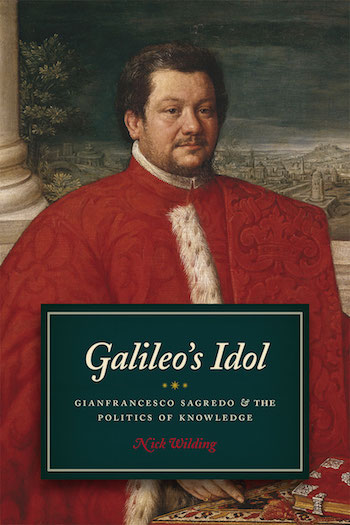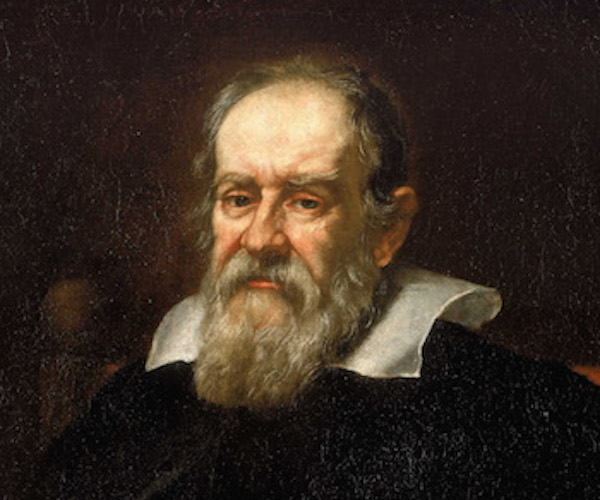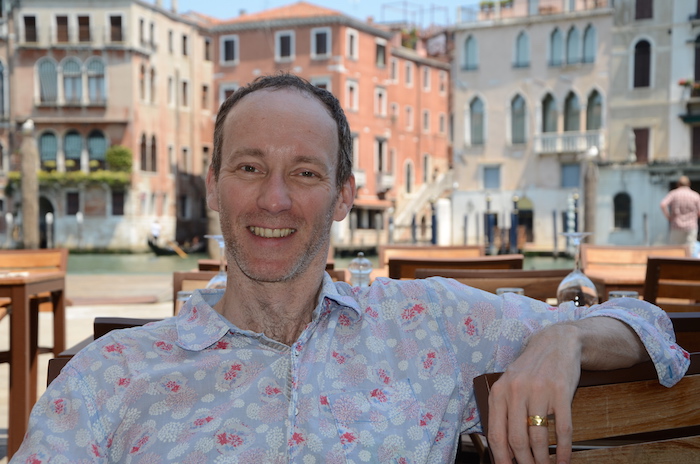Book Review: More than Meets the Eye — “Galileo’s Idol: Gianfrancesco Sagredo and the Politics of Knowledge”
Readers interested in early modern science, Renaissance studies, or Galileo will undoubtedly savor this trailblazing historical work.
Galileo’s Idol: Gianfrancesco Sagredo and the Politics of Knowledge by Nick Wilding, University of Chicago Press, 232 pages, $35.00.
By Justin Grosslight

Historian of science Nick Wilding has become a cause célèbre among Renaissance aficionados. An expert on the world of Italian mathematician Galileo Galilei (1564–1642), he recently examined watercolors, library stamps, and a misspelled word on the title page of two volumes of Galileo’s Sidereus nuncius (1610) and argued—much to the shock of antiquarians and forensic experts—that these copies of the famed work were forgeries. Wilding also examined the sole extant copy of Thomas Salisbury’s Life of Galileo (1664), which had remained cloistered in a private library for decades until Sotheby’s auctioned it off a few years back. Through his examination of this first substantial biography of Galileo, Wilding showed how Galileo’s disciple Vincenzo Viviani (1622–1703)—together with interventions by Leopoldo de’ Medici (1617–1675) and the Inquisition—vied for control of Galilean documents. The aim was to attempt to shape Galileo’s legacy.
In his latest work, Galileo’s Idol: Gianfrancesco Sagredo and the Politics of Knowledge, Wilding promises to tell a gripping tale of “machinations, maneuvers, and masks in the making of early modern scientific knowledge.” The lost world of Galileo’s confidant and Venetian polymath Gianfrancesco Sagredo (1571–1620) provides the key to the intrigues. And the scholar makes good on his boast—he discovers plenty of fascinating stratagems.
Wilding’s narrative is judiciously divided into seven chapters. Each segment either examines a facet of Sagredo’s character or contextualizes Galileo’s activities that occurred parallel to his friend’s pursuits. The opening chapter locates a well-documented but lost 1619 portrait of Sagredo made by Renaissance painter Gerolamo Bassano (1566–1621) that hung in Galileo’s living room as the mathematician immortalized his comrade (via a fictionalized persona) in his famous Dialogue Concerning the Two Chief World Systems (1632) and Discourse and Mathematical Demonstration Relating to Two New Sciences (1638). Through careful reading of Sagredo’s letters, Wilding discovered that Bassano also had painted a portrait of Sagredo seven years earlier. This information inspired him to search for the famed 1619 masterpiece.
Via Internet searches, digital journal archives, and a dose of serendipity, Wilding unearthed both Sagredo portraits (as well as a photographic negative of a third). When he examined a 1991 Burlington Magazine review of an earlier catalogue of Italian portraits held by Soviet museums, Wilding experienced a Eureka moment: the Ukraine’s Zhytomyr Regional Museum boasted of having a portrait of Sagredo painted by Gerolamo’s brother, Leandro Bassano (1557–1622). Upon viewing this image, Wilding noted its similarities to a misattributed piece by Leandro Bassano housed in the Ashmolean Museum, Oxford. Analysis of the Persian rug and the lighthouse of Alexandria in the Oxford painting corroborated Wilding’s hunch. The work indeed portrays Sagredo: for only Sagredo possessed the distinctive Persian tapestry (acquired through the networks he built while in Aleppo) and optics skill among his Venetian contemporaries. Curiously, authorship of both portraits seems to have been garbled: while Gerolamo actually painted the 1612 portrait, both brothers worked intermittently on the 1619 picture. The latter point undergirds one of the book’s major leitmotifs: authorship is neither a straightforward nor a linear process.
Chapter two digs into Sagredo’s protean nature as an independent, multifaceted intelligencer. Though ostensibly anti-Jesuit in the wake of Venice’s 1591 uprisings, the nimble Sagredo maintained various contradictory tactical ties: to the Jesuit system, to its opposition at the University of Padua, to the eclectic intellectual circle headed by Gian Vincenzo Pinelli (1535–1601), and to individuals who held sway in international affairs. Sagredo corresponded regularly with Jesuit superior general Claudio Acquaviva (1543–1615). And, though unsuccessful, he pleaded with University of Padua rector Zaccaria Contarini (1526–1602) to increase Galileo’s salary. Sagredo was also a fallback intermediary for Danish emissary Franz Tengnagel (1576–1622), who wanted the former to promote the work and legacy of astronomer Tycho Brahe (1546–1601). Using his growing clout, Sagredo expanded his contacts across Europe: when urging the Venetian Senate to repossess goods stolen by English pirates, he branded himself as a “great Magneticall man” in order to solicit ideas from natural philosopher William Gilbert (1544–1603). Within a few years, Sagredo established himself as a pivotal member of the Venetian intelligentsia, which held powerful sway in diplomatic and philosophical circles.
As Sagredo made use of his networks, Galileo made his living by way of a private tuition clientele generated through applied mathematics lessons (He focused on topics largely absent from the Aristotelian university mathematics curriculum). Drawing on Galileo’s compass (or calculating instrument) as a model for the mathematician’s scheming, Wilding next highlights Galileo’s socio-epistemological and authorial maneuvers. Beginning in the 1590s, Galileo created compasses along with manuscript instruction booklets; the instruments were sold or given to local elites, thus providing Galileo with necessary monetary and/or social capital. Worried that his intellectual monopoly would be endangered as more people became acquainted with his instrument, Galileo printed a number of copies of his instruction manual. This was Galileo’s attempt to retain authorial authority over an instrument for which he did not hold a patent. The tactic was not entirely successful. Galileo’s former student Baldassarre Capra (1580–1626) claimed credit, in print, for inventing the compass. To reassert his authority, Galileo penned a Difesa (1607), solicited authorial depositions from Paduan witnesses, and had his friend Paolo Sarpi (1552–1623) cross-examine Capra, who was eventually found guilty of plagiarism and incompetence. Capra ultimately recanted and his books were destroyed at Galileo’s request. Interestingly, this imbroglio helped Galileo gain visibility with a wider audience, which included the Medici.

Galileo Galilei—he needed the media and alliances in order to thrive.
Chapter four illustrates how Sagredo used the skills he learned as treasurer to the Friulian fortress of Palmanova (1605–1607) to intercept and manipulate documents. Upon returning to Venice he embarked on a pseudonymous epistolary war with the Jesuits. Fabricating the persona of a batty old hag named Cecilia Contarini, Sagredo corresponded with Jesuit father Antonio Barisone (fl. 1608), who also assumed a pseudonym—Rocco Berlinzone—in their exchanges. Their correspondence exposed Jesuit attempts to create a political system that would have threatened Venetian independence. The letters also highlighted the controversial views of certain confessors in Venice, bandied about the names of local Jesuit sympathizers, and explored loopholes whereby the invented ‘Contarini’ could bequeath her possessions to the Society. Though the correspondence was politically contentious, Sagredo occasionally found the correspondence amusing; he relished explaining the rhetorical traps in his letters to Galileo, Sarpi, and ultimately to Barisone and others.
During his tenure as Venetian consul in Aleppo (1608–1611), Sagredo sustained his charades with the Jesuits by contacting fathers in Goa about magnetism-related matters while testing his hypotheses on magnetic declension values. On a more serious note, the fifth chapter argues that these were the years when Sagredo mastered the art of intercepting and copying diplomatic letters. He facilely copied documents written in Persian, Portuguese, Turkish, and Arabic—languages he did not know—and often decoded the classified, ciphered information that fell into his hands. Such missives contained sensitive information concerning Carmelite and Augustinian affairs outside Europe, these orders’ relations with global rulers, Shah Abbas of Persia’s desire to avoid war with the Ottomans, and Persia’s desire to bypass Venice by letting the Spanish bring its silk trade into Hormuz. Unfortunately, it appears that Sagredo overstepped his boundaries by informing his homeland about hush-hush matters—Venice’s Council of Ten exhorted him to cease his epistolary hijacking and destroy all of his copied documents. To ensure that lips would remain sealed, inquisitors in Venice covered up Sagredo’s indiscretions.
While Sagredo was in Aleppo, Galileo put out his famed Sidereus nuncius, whose publication is examined in chapter six. Wilding begins by analyzing Galileo’s choice of the word “nuncius” in the title, which draws on notions of the avviso and relazione, variants of news reports in post-Interdict Venice. By positing that the earth was like the rest of the cosmos and that Jupiter had moons, Galileo moved the notion of broadcasting from the political into the cosmic realm. Next, Wilding traces the material history of four Sidereus woodcuts, revealing that the Sidereus’ printer was not Tommaso Baglioni (fl. 1607–1615) as stated on the booklet’s cover page and as scholars have universally accepted. Rather, Paduan printer Roberto Meietti (ca. 1550–1634), who had been excommunicated in 1606 for publishing heretical works, is the one who released the book.
Galileo’s rationale for choosing Meietti was straightforward: the Sidereus had been published on March 15, 1610, and Meietti was likely the only publisher who could guarantee its authoritative debut at the prominent Frankfurt book fair, which began only thirteen days later. Galileo also had used Meietti for the publication of his 1607 Difesa. The publisher had enough prominence to ward off encroaching inquisitors in Venice as well as to strengthen Galileo’s reputation. Yes, Galileo risked excommunication by using Meietti, but the mathematician’s hazardous choice was understandable given the potential payoffs made possible by exploiting the latter’s networks.
Wilding’s final chapter assesses the “honesty” of authorship by exploring the manipulative ambiguities of style. In it, he claims that Galileo’s Sidereus nuncius is, in its entirety, “a mask.” Unlike the pseudonyms discussed in previous chapters, which were used to obviate censorship, the onymous Sidereus is a mask in the mode of a carnival disguise: the goal of the dissimulation is to make the writing’s content “shocking in its claims, irreverent in its tone, and subversive in its cosmology.” Looking next at the epistolary exchanges between Galileo and Ingolstadt-based Jesuit Christoph Scheiner (1573–1650) on the nature and causes of sunspots, Wilding maps out the diverse forms of authorial subterfuge at play. In this case, Galileo sparred with a pseudonymous “Apelles”; Augsburg humanist Marcus Welser (1558–1614) served as a middleman in the debate. With guile, Sagredo intercepted the letters that passed through Venice, deliberately disrupting the exchanges. Sagredo hoped to expose Welser as a Habsburg (hence anti-Venetian) and Jesuit sympathizer with ulterior political motives. Moreover, he aimed to show not only that “Apelles” was a fraud, but that his arguments were fraudulent as well. Further authorship games ensued in Galileo’s Il saggiatore (1623), where the mathematician attacked the work of Jesuit Orazio Grassi (1583–1684). The take-home message: in early modern natural philosophy or experimental science, modern notions of authorship do not apply.

Historian and master sleuth Nick Wilding. Photo: Courtesy of the author.
Taken in terms of its challenge to conventional scholarship, Galileo’s Idol is a tour de force. Theoretically, the work drives a stake deep into the heart of traditional sociology of science, in which there is an assumed homomorphy between authorial identities and natural philosophical discovery. By proving that actors’ identities are historically situated, and thus can be constructed, Wilding underscores the fact that the act of writing and producing early modern science was inevitably contextual. Galileo’s Idol also highlights the bedeviling complexities of authorship: the name associated with a creator of a text—and perhaps a work itself—is a mutable, moving target. Wilding’s second chapter also makes a noteworthy point: that a “public” emerged through the circulation of anti-Jesuit manuscripts, thus suggesting an alternative to how historians conceptualize the public sphere’s emergence materially and temporally.
Equally impressive are the book’s methodological accomplishments. Most obvious is the breadth of painstaking research that Wilding has conducted—sometimes in archives with misdated and misordered papers—in resurrecting Sagredo. Now, for the first time since his passing, we can see Sagredo in action, debating alongside a new, multivalent version of a Galileo who needed the media and alliances in order to thrive. While doing his legwork, Wilding illuminates both the strengths and limitations of the scholarship of Antonio Favaro (1847–1922). Arguably the doyen of modern Galileo scholarship, Favaro edited most of Galileo’s major works and correspondence. He even wrote on Sagredo. Yet Favaro’s conventional archival and bibliographic gaze led him away from understanding how the marginal—obscure portrait references, verses of poetry, sketches of Medicean stars on envelopes—could provide crucial clues for locating Sagredo.
Galileo’s Idol also succeeds in providing a view (from the bottom) of the Venetian patriciate and shows the value of viewing Venetian science alongside the evolution of Persian affairs. Finally, given the bold results of his expansive sleuthing, Wilding convincingly suggests (at least indirectly) that historians embrace an interdisciplinary research agenda, because “deepening divisions between academic disciplines separated the fragments [of Sagredo’s existence] further.”
Splendid as it is, Galileo’s Idol is not without its flaws. The volume lives up to the latter part of its subtitle, “The Politics of Knowledge,” but it sometimes lacks direct engagement with its star, “Gianfrancesco Sagredo.” While Galileo unquestionably revered Sagredo, certain chapters that focus primarily on Galileo provide only circumstantial evidence linking the two men. It should also be mentioned—as historian Matteo Valleriani has recently shown—that Sagredo and Galileo corresponded about several issues related to engineering, including how to make high-quality glass with rock crystal and manganese, how to conduct experiments with curved mirrors, and how to make thermometry measurement devices. Even though Wilding insists he is not writing a full-blown biography, a discussion of these topics would have enhanced his goal of “coming at [Galileo] sideways” via Sagredo. (A bibliographic quibble: page numbers are missing in some of the referred to book chapters or journal articles, which creates problems for curious readers who want to follow Wilding’s trail.)
Overall, Galileo’s Idol is an exciting success. Wilding uses his formidable research—examining Persian carpets, scouring the Internet, putting in months of vast archival work—to create an enthralling portrait of a dynamic and entertaining Gianfrancesco Sagredo. The narrative’s prose is vigorous and fun to read; and the text is augmented by plates that provide tantalizing images of Wilding’s fascinating hero. Readers interested in early modern science, Renaissance studies, or Galileo should savor this trailblazing historical work.
Justin Grosslight is an academic entrepreneur interested in examining relationships between science and business. He is especially intrigued by how networks operate (quantitatively and qualitatively), both from historical and from contemporary perspectives. He holds degrees in history and mathematics from Stanford, a history of science degree from Harvard, and has published in all three fields. He currently is working in Vietnam, but also has lived in Italy and the United States.
